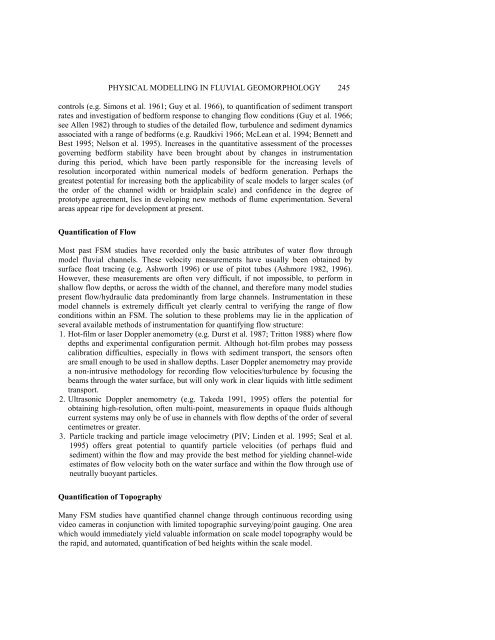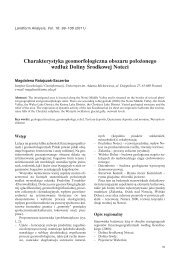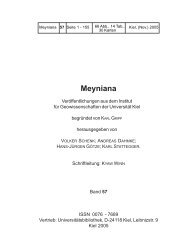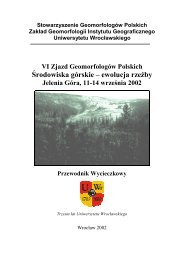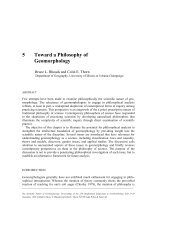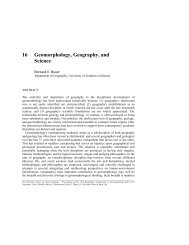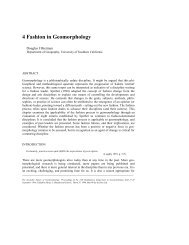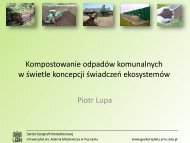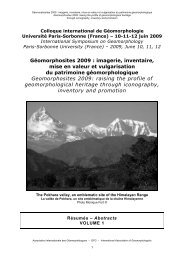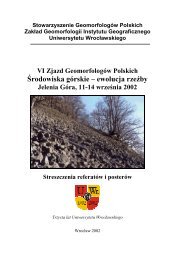Physical Modelling in Fluvial Geomorphology
Physical Modelling in Fluvial Geomorphology
Physical Modelling in Fluvial Geomorphology
You also want an ePaper? Increase the reach of your titles
YUMPU automatically turns print PDFs into web optimized ePapers that Google loves.
PHYSICAL MODELLING IN FLUVIAL GEOMORPHOLOGY 245<br />
controls (e.g. Simons et al. 1961; Guy et al. 1966), to quantification of sediment transport<br />
rates and <strong>in</strong>vestigation of bedform response to chang<strong>in</strong>g flow conditions (Guy et al. 1966;<br />
see Allen 1982) through to studies of the detailed flow, turbulence and sediment dynamics<br />
associated with a range of bedforms (e.g. Raudkivi 1966; McLean et al. 1994; Bennett and<br />
Best 1995; Nelson et al. 1995). Increases <strong>in</strong> the quantitative assessment of the processes<br />
govern<strong>in</strong>g bedform stability have been brought about by changes <strong>in</strong> <strong>in</strong>strumentation<br />
dur<strong>in</strong>g this period, which have been partly responsible for the <strong>in</strong>creas<strong>in</strong>g levels of<br />
resolution <strong>in</strong>corporated with<strong>in</strong> numerical models of bedform generation. Perhaps the<br />
greatest potential for <strong>in</strong>creas<strong>in</strong>g both the applicability of scale models to larger scales (of<br />
the order of the channel width or braidpla<strong>in</strong> scale) and confidence <strong>in</strong> the degree of<br />
prototype agreement, lies <strong>in</strong> develop<strong>in</strong>g new methods of flume experimentation. Several<br />
areas appear ripe for development at present.<br />
Quantification of Flow<br />
Most past FSM studies have recorded only the basic attributes of water flow through<br />
model fluvial channels. These velocity measurements have usually been obta<strong>in</strong>ed by<br />
surface float trac<strong>in</strong>g (e.g. Ashworth 1996) or use of pitot tubes (Ashmore 1982, 1996).<br />
However, these measurements are often very difficult, if not impossible, to perform <strong>in</strong><br />
shallow flow depths, or across the width of the channel, and therefore many model studies<br />
present flow/hydraulic data predom<strong>in</strong>antly from large channels. Instrumentation <strong>in</strong> these<br />
model channels is extremely difficult yet clearly central to verify<strong>in</strong>g the range of flow<br />
conditions with<strong>in</strong> an FSM. The solution to these problems may lie <strong>in</strong> the application of<br />
several available methods of <strong>in</strong>strumentation for quantify<strong>in</strong>g flow structure:<br />
1. Hot-film or laser Doppler anemometry (e.g. Durst et al. 1987; Tritton 1988) where flow<br />
depths and experimental configuration permit. Although hot-film probes may possess<br />
calibration difficulties, especially <strong>in</strong> flows with sediment transport, the sensors often<br />
are small enough to be used <strong>in</strong> shallow depths. Laser Doppler anemometry may provide<br />
a non-<strong>in</strong>trusive methodology for record<strong>in</strong>g flow velocities/turbulence by focus<strong>in</strong>g the<br />
beams through the water surface, but will only work <strong>in</strong> clear liquids with little sediment<br />
transport.<br />
2. Ultrasonic Doppler anemometry (e.g. Takeda 1991, 1995) offers the potential for<br />
obta<strong>in</strong><strong>in</strong>g high-resolution, often multi-po<strong>in</strong>t, measurements <strong>in</strong> opaque fluids although<br />
current systems may only be of use <strong>in</strong> channels with flow depths of the order of several<br />
centimetres or greater.<br />
3. Particle track<strong>in</strong>g and particle image velocimetry (PIV; L<strong>in</strong>den et al. 1995; Seal et al.<br />
1995) offers great potential to quantify particle velocities (of perhaps fluid and<br />
sediment) with<strong>in</strong> the flow and may provide the best method for yield<strong>in</strong>g channel-wide<br />
estimates of flow velocity both on the water surface and with<strong>in</strong> the flow through use of<br />
neutrally buoyant particles.<br />
Quantification of Topography<br />
Many FSM studies have quantified channel change through cont<strong>in</strong>uous record<strong>in</strong>g us<strong>in</strong>g<br />
video cameras <strong>in</strong> conjunction with limited topographic survey<strong>in</strong>g/po<strong>in</strong>t gaug<strong>in</strong>g. One area<br />
which would immediately yield valuable <strong>in</strong>formation on scale model topography would be<br />
the rapid, and automated, quantification of bed heights with<strong>in</strong> the scale model.


